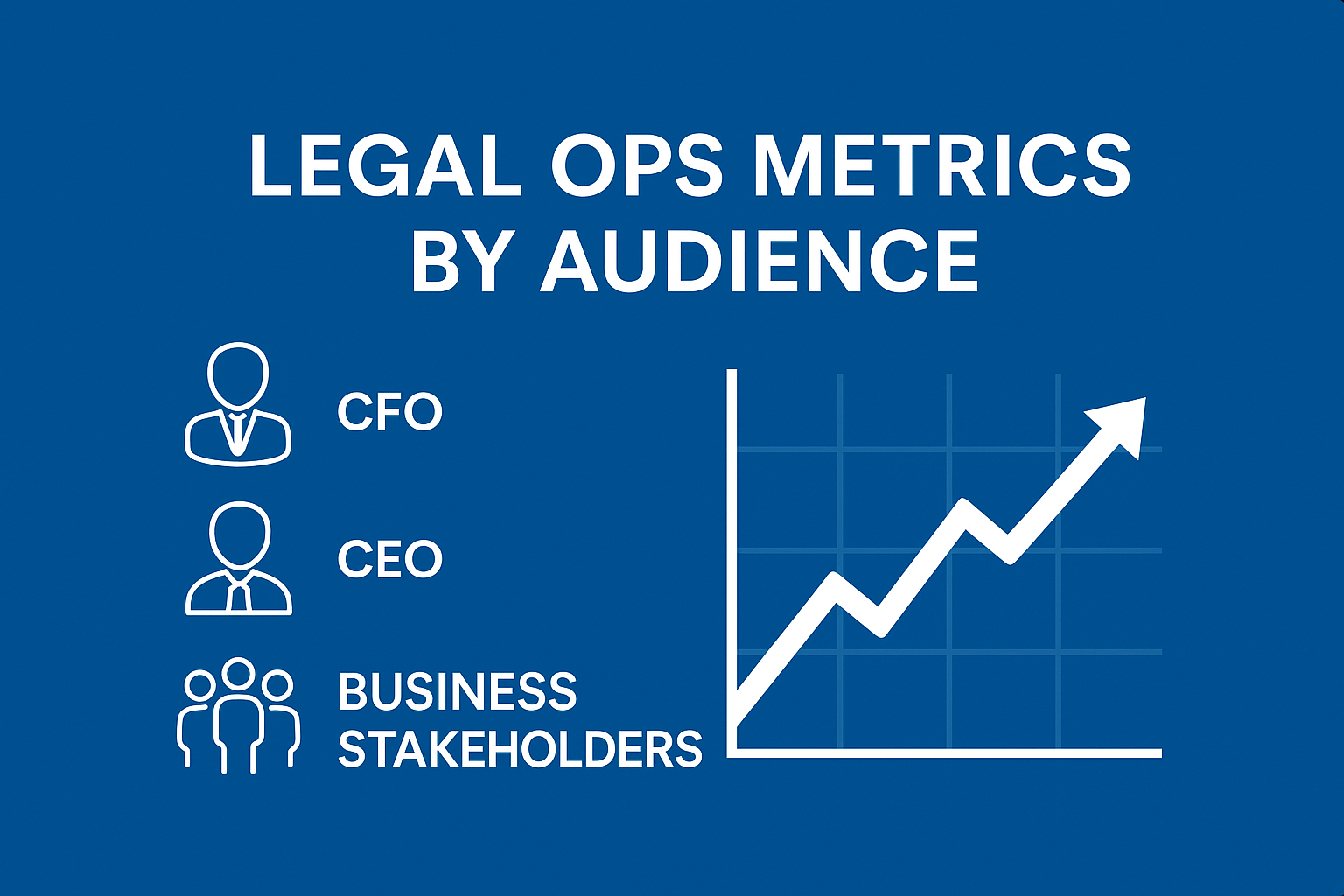
In-house GCs and legal ops leaders, does this sound familiar? You put together an executive chart showing how many contracts your legal team drafted, how many matters you handled, how much you spent on outside counsel, and how much you need for new software…and you were met with blank stares and maybe a “why do you need that many FTEs?”
In our last post, we talked about why in-house legal teams need smarter metrics: numbers that connect legal work to business outcomes. But it’s not just the numbers that matter. Even the smartest metrics can miss their mark if you don’t tailor them to your audience.
Different leaders care about different things. Your CFO thinks in cost and ROI. Your CEO thinks in growth and risk posture. Your business stakeholders think in speed and enablement.
If you want your reports to drive true alignment — not just nods — you need to translate legal metrics into the terms your leaders already use to measure success. What’s important isn’t the numbers; it’s the story they tell. Get the story right, and you build trust.
The Misalignment Problem
Most legal teams already report their metrics…but too often, they report them the same way to everyone.
One slide deck. One dashboard. One set of charts that’s supposed to satisfy the CFO, the CEO, and half a dozen business leaders.
It never quite works.
That’s because the same data tells different stories depending on who’s reading it. A 20% reduction in cycle time might just sound like an efficiency win to Legal Ops — but to Finance, it means lower external counsel spend. To Sales, it means faster deals. And to the CEO, it means more predictable revenue.
When Legal shares numbers without translation, executives hear noise instead of impact. They can see activity, but not how that activity drives the business forward.
The result: a metrics program that informs Legal, but fails to inspire leadership.
The solution is simple, but strategic: stop reporting metrics in Legal’s language, and start reporting them in the language of the business.
Metrics as Translation
Think of metrics as a kind of language. The data itself doesn’t change, but the meaning does, depending on who’s listening.
The most effective legal ops teams act as translators between Legal and the rest of the business. They take the same set of numbers and frame them through different lenses, showing each leader what those numbers actually mean in their world.
Take one common KPI: contract cycle time.
To the CFO, it’s proof of cost control: fewer review rounds mean fewer outside counsel hours.
To the CEO, it’s a growth signal: faster deals mean faster revenue recognition.
To your business stakeholders, it’s a measure of enablement: they can close deals, onboard vendors, or launch campaigns without getting stuck in review bottlenecks.
Same data. Three audiences. Three different stories about impact.
This is the heart of strategic reporting: not changing the facts, but tailoring the frame so every stakeholder sees Legal’s contribution in their own terms.
Here’s how.
CFO: ROI, Spend, and Resource Efficiency
Your CFO is fluent in efficiency. Speak their language.
When Legal reports to Finance, every number should tie back to cost, return on investment, or resource allocation. Your CFO isn’t looking for a narrative about contracts; they’re looking for proof that Legal’s work drives measurable financial outcomes.
Key metrics to highlight:
- Outside counsel spend reduction: Show how automation, better templates, and standardized playbooks shrink invoices and external hours.
- Cost per contract or matter: Reveal the cost efficiency (typically measured in worker hours) of your internal processes — a simple, powerful way to benchmark Legal against other departments.
- Revenue acceleration through faster contracting: Every day saved in review accelerates revenue recognition.
How to communicate it:
Present Legal’s process improvements the same way Finance reports on system upgrades or cost initiatives: quantify the gain, not just the effort. Show that your investments in workflow or technology produce tangible ROI.
Translate this metric:
“Reducing contract cycle time by 15% didn’t just speed things up; it freed budget capacity and helped recognize revenue a full week earlier each quarter.”
Other Business Stakeholders: Responsiveness and Enablement
Your business partners are fluent in momentum. Prove you’re helping them keep it.
For internal clients — Sales, Procurement, HR, Marketing — success is measured in outcomes, not metrics. They care about how Legal supports their ability to move fast, stay compliant, and avoid rework.
Key metrics to highlight:
- Turnaround time per request or contract type: Show that Legal helps keep projects and deals on schedule.
- Template adoption and self-service rates: Quantify how much your enablement tools let teams act independently without bottlenecks.
- Stakeholder satisfaction (survey or NPS): Capture how teams actually experience working with Legal — their perception of value and responsiveness.
How to communicate it:
Focus on friction reduction: how Legal helps teams move faster, close deals more smoothly, and prevent last-minute crises. Keep the story personal and practical.
Translate this metric:
“Last quarter, 60% of NDAs were handled entirely through self-service templates, freeing both Legal and Sales to focus on higher-value deals.”
The “So What?” Test
Before you send out your next metrics report, pause for a moment and run this “So What?” test.
Every chart, dashboard, or KPI should answer one of three questions for your audience:
- Does this data explain how Legal impacts revenue, cost, or risk?
- Can my audience immediately see the business outcome behind the number?
- If they only remember one takeaway, is it something that would help them make a decision?
If the answer to any of these is no, the metric may still be useful…but it’s not ready for the C-suite.
The best Legal Ops reports don’t just summarize activity. They connect dots between legal performance and business priorities. They translate data into credibility.
When your metrics tell the right story, executives stop seeing Legal as a cost center, and start seeing it as an enabler of strategy.
Conclusion: From Reporting to Influence
Metrics are powerful, but only when they’re understood.
Legal ops sits at the intersection of business, finance, and risk. That positions your team uniquely to turn data into dialogue — to show how legal performance drives growth, stability, and smarter decisions across the company.
The difference between a good report and a great one isn’t the number of KPIs. It’s whether every metric speaks the language of its audience.
When your CFO sees ROI, your CEO sees strategy, and your business leaders see momentum, you’ve done more than build a dashboard; you’ve built influence.
Because the real value of metrics isn’t in what they measure. It’s in what they make possible.
Want to see which KPIs matter most, and how to build a metrics program that connects Legal’s work directly to business results?
Download our free guide: In-House Metrics That Matter: Legal Ops KPIs and Contract ROI.

